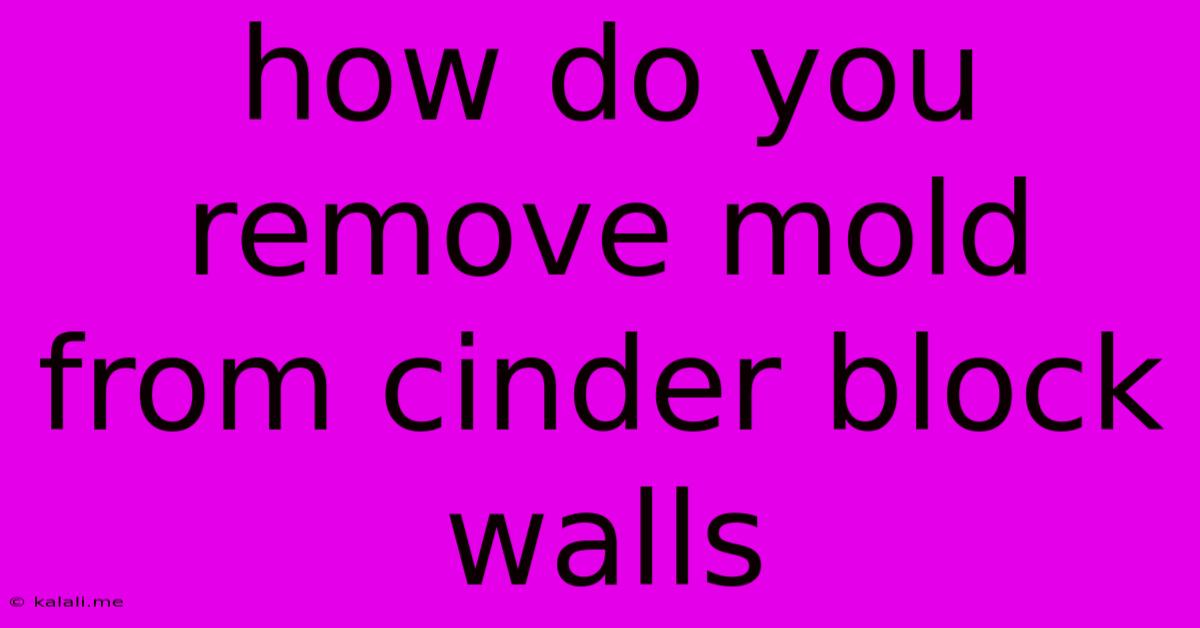How Do You Remove Mold From Cinder Block Walls
Kalali
Jun 02, 2025 · 4 min read

Table of Contents
How to Remove Mold from Cinder Block Walls: A Comprehensive Guide
Mold growth on cinder block walls is a common problem, especially in damp or humid environments. Not only is it unsightly, but mold can also pose significant health risks, triggering allergies and respiratory issues. This comprehensive guide will walk you through the safe and effective removal of mold from your cinder block walls, equipping you with the knowledge to tackle this problem head-on. This involves identifying the source of moisture, preparing the area, and employing the right cleaning methods. Ignoring mold growth is not an option; tackling it promptly is key to a healthy home.
Identifying the Source of Moisture: The First Step to Mold Removal
Before you even begin cleaning, it's crucial to pinpoint the source of the moisture that's fueling the mold growth. This is the most important step in preventing future infestations. Common culprits include:
- Leaks: Check for leaks in your roof, pipes, or windows. Even tiny leaks can lead to significant mold problems over time.
- Condensation: Poor ventilation can cause condensation to build up on cool surfaces like cinder block walls, creating the perfect breeding ground for mold.
- High Humidity: Excessive humidity in the air can contribute to mold growth. Consider using a dehumidifier to lower humidity levels.
- Ground Water: Check for any signs of rising dampness from the ground.
Addressing the source of the moisture is vital. Simply cleaning the mold without fixing the underlying problem will only lead to a recurring infestation.
Preparing for Mold Removal: Safety First
Mold remediation requires caution. Always prioritize your safety:
- Protective Gear: Wear protective gear including N95 respirator mask, gloves, eye protection, and long sleeves and pants to protect your skin and respiratory system from mold spores.
- Ventilation: Ensure good ventilation in the area by opening windows and doors. Use fans to circulate air and help remove spores.
- Containment: If the mold infestation is extensive, consider containing the affected area with plastic sheeting to prevent the spread of spores during cleaning.
- Disposal: Dispose of all cleaning materials and contaminated debris properly in sealed plastic bags.
Cleaning Mold from Cinder Block Walls: A Step-by-Step Approach
Once you've identified the moisture source and taken necessary safety precautions, you can begin cleaning the mold. Here's a step-by-step approach:
-
Assess the extent of the damage: Determine how much of the wall is affected. Small areas can be treated differently than large infestations.
-
Scrubbing with a solution: For small areas, a mixture of water and detergent, or a commercial mold cleaner is effective. Apply the solution to the affected area and gently scrub using a stiff brush. Rinse thoroughly with clean water.
-
Harder methods: For larger, stubborn mold areas, consider using a solution of bleach and water (1 part bleach to 10 parts water). Always test this solution in an inconspicuous area first to ensure it doesn't damage the cinder blocks. Apply the solution and let it sit for 10-15 minutes before scrubbing and rinsing thoroughly. Be mindful that bleach can be damaging to certain surfaces, so proceed with caution.
-
Drying the area: After cleaning, thoroughly dry the wall. Use fans to circulate air and speed up the drying process. Ensure the wall is completely dry before replacing any damaged materials or painting.
-
Professional help: For large or persistent mold problems, it's best to consult a professional mold remediation specialist. They have the expertise and equipment to handle significant infestations safely and effectively.
Preventing Future Mold Growth: Long-Term Solutions
After cleaning the mold, take preventative measures to avoid future infestations:
- Improve Ventilation: Ensure adequate ventilation in the area to reduce humidity. Use exhaust fans in bathrooms and kitchens.
- Repair Leaks: Fix any leaks in your roof, pipes, or windows promptly.
- Control Humidity: Use a dehumidifier to control humidity levels, especially in damp areas.
- Regular Inspection: Regularly inspect your cinder block walls for signs of mold growth. Early detection allows for easier and more effective treatment.
By following these steps and implementing preventative measures, you can effectively remove mold from your cinder block walls and create a healthier and safer living environment. Remember, safety and addressing the root cause of the moisture are paramount in this process.
Latest Posts
Latest Posts
-
How Long To Soak Red Beans
Jun 04, 2025
-
Was Jesus Crucified On The Passover
Jun 04, 2025
-
Fortune Cowsay Lolcat Not Working In Zshrc
Jun 04, 2025
-
Bathroom Sink Drains Slow No Clog
Jun 04, 2025
-
No Toilet Flush Drains Backed Up Gurgling
Jun 04, 2025
Related Post
Thank you for visiting our website which covers about How Do You Remove Mold From Cinder Block Walls . We hope the information provided has been useful to you. Feel free to contact us if you have any questions or need further assistance. See you next time and don't miss to bookmark.